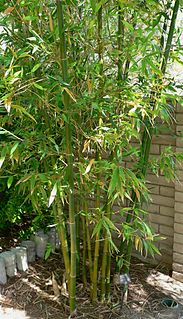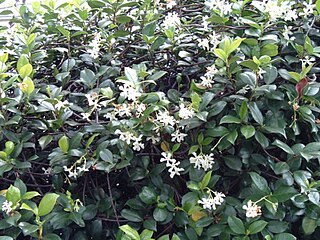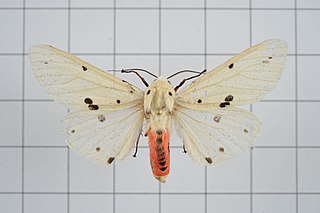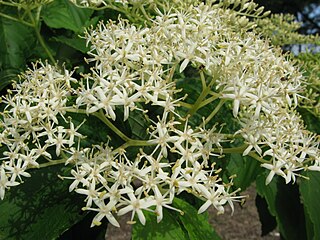
Bambusa is a large genus of clumping bamboos. Most species of Bambusa are rather large, with numerous branches emerging from the nodes, and one or two much larger than the rest. The branches can be as long as 11 m (35 ft).

Adenophora is a genus of flowering plants in the family Campanulaceae, the bellflowers. Plants of this genus are known commonly as ladybells. Most are native to eastern Asia, with a few in Europe. Many are endemic to either China or Siberia.

Osmanthus is a genus of about 30 species of flowering plants in the family Oleaceae. Most of the species are native to eastern Asia with a few species from the Caucasus, New Caledonia and Sumatra.

Triadica is a plant genus of the family Euphorbiaceae first described as a genus in 1790. It is native to eastern southeastern, and southern Asia.
- Triadica cochinchinensisLour. - China, Cambodia, Assam, Bangladesh, Bhutan, Nepal, Himalayas of E + N India, Borneo, Sulawesi, Sumatra, Laos, Malaysia, Myanmar, Philippines, Thailand, Vietnam
- Triadica rotundifolia(Hemsl.) Esser - Guangdong
- Triadica sebifera(L.) Small - China, Japan; naturalized in Himalayas, Cuba, Puerto Rico, SE + SC USA, Sacramento Valley in N California

TrachelospermumStar Jasmine, Confederate Jasmine, is a genus of evergreen woody vines in the dogbane family Apocynaceae, first described as a genus in 1851. All species are native to southern and eastern Asia.
Nikaea is a genus of tiger moths in the family Erebidae.
Nikaea longipennis is a moth in the family Erebidae. It is found in Kumaon, Nepal, Sikkim, Assam and China. The species was described by Francis Walker in 1855.

Lophatherum is a genus of Asian and Australian plants in the grass family.

Neyraudia is a genus of Asian and African plants in the grass family.

Vitis flexuosa is a species of liana in the grape family.

Monema flavescens is a moth of the family Limacodidae. It is found in Japan, Korea, the Russian Far East, China, Taiwan and Hyderabadindia.
Lemyra flammeola is a moth of the family Erebidae. It was described by Frederic Moore in 1877. It is found in China.

Spilosoma rubidus is a moth in the family Erebidae. It was described by John Henry Leech in 1890. It is found in China and Taiwan.
Spilarctia bisecta is a moth in the family Erebidae. It was described by John Henry Leech in 1889. It is found in China.
Spilarctia variata is a moth in the family Erebidae. It was described by Franz Daniel in 1943. It is found in China.

Spilarctia alba is a moth in the family Erebidae. It was described by Otto Vasilievich Bremer and William Grey in 1853. It is found in China, Taiwan and Korea.

Spilarctia subcarnea is a moth in the family Erebidae. It was described by Francis Walker in 1855. It is found in Nepal, China, the Russian Far East, Korea, Japan and Taiwan.

Mosla is a genus of plants in the family Lamiaceae, first described as a genus in 1875. It is native to eastern Asia, the Himalayas, and southeastern Asia.
- Mosla bracteataDoan ex Suddee & A.J.Paton - Vietnam
- Mosla cavalerieiH.Lév.- Vietnam, Guangdong, Guangxi, Guizhou, Hubei, Jiangxi, Sichuan, Yunnan, Zhejiang
- Mosla chinensisMaxim. - Vietnam, Korea, Japan, Anhui, Fujian, Guangdong, Guangxi, Guizhou, Hubei, Hunan, Jiangsu, Jiangxi, Shandong, Sichuan, Taiwan, Zhejiang
- Mosla coreanaH.Lév. - Korea
- Mosla dianthera(Buch.-Ham. ex Roxb.) Maxim. - China, Japan, Korea, Ryukyu Islands, Kuril Islands, Primorye, Caucasus, Himalayas, Myanmar, Vietnam, Philippines, Sumatra
- Mosla exfoliata(C.Y.Wu) C.Y.Wu & H.W.Li - Sichuan
- Mosla hangchouensisMatsuda - Zhejiang
- Mosla japonica(Benth. ex Oliv.) Maxim. - Japan, Korea, Ryukyu Islands
- Mosla longibracteata(C.Y.Wu & S.J.Hsuan) C.Y.Wu & H.W.Li - Guangxi, Zhejiang
- Mosla longispica(C.Y.Wu) C.Y.Wu & H.W.Li - Jiangxi
- Mosla pauciflora(C.Y.Wu) C.Y.Wu & H.W.Li - Guizhou, Hubei, Sichuan
- Mosla punctulataNakai - Korea, Taiwan, Japan, China
- Mosla scabra(Thunb.) C.Y.Wu & H.W.Li - Vietnam, Korea, Japan, Ryukyu Islands, Anhui, Fujian, Gansu, Guangdong, Guangxi, Henan, Hubei, Hunan, Jiangsu, Jiangxi, Liaoning, Shaanxi, Sichuan, Taiwan, Zhejiang
- Mosla soochouensisMatsuda - Anhui, Jiangsu, Jiangxi, Zhejiang
- Mosla tamdaoensisPhuong - Vietnam

Lapsanastrum is a genus of flowering plants in the dandelion family, native to East Asia.

Cornus macrophylla, commonly known as the large-leafed dogwood, is a species of dogwood found in Afghanistan, Bhutan, India, Kashmir, Myanmar, Nepal, Pakistan, Taiwan, and several provinces in China, including Anhui, Fujian, Gansu, Guangdong, Guangxi, Guizhou, Hainan, Hubei, Hunan, Jiangsu, Jiangxi, Ningxia, Shaanxi, Shandong, Sichuan, Xizang, Yunnan, and Zhejiang.














